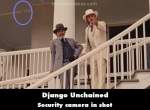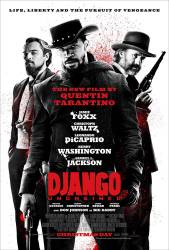Factual error: Dr Schultz pays with 12 $1000 bills, but $1000 bills were not created until 1861, after the time period of this movie.
Factual error: In the scene after the Mandingo fight in the Cleopatra club, when Leonardo DiCaprio gives his slave a beer, it is served in a flip top bottle. The first flip-top closure was created by Charles de Quillfeldt in the United States, who filed for a patent on 30 November 1874, receiving patent number 158406.
Factual error: The film is based in 1858 and proceeds through the winter into the spring of 1859. At the end of the movie Django blows up Candyland using dynamite. Dynamite was not invented by Alfred Nobel until 1864 and then patented in 1867.
Factual error: The harpist is playing "Fur Elise", which though written in 1810, was not published until 1865.
Factual error: Dr. Schultz says the word "Malarkey" in casual conversation in 1858, the word didn't come into use until 1929.
Factual error: The "Cleopatra Club", where Django, Schultz and Monsieur Candie meet for the first time, uses an Egyptian sculpture replica as a trademark, which resembles the famous Nefertiti bust; this was only discovered in December 1912, by a German archaeologist.
Factual error: In several scenes throughout the film, characters are shown wearing pants which have belt loops. While belts were used in the past, belt loops on pants did not come into usage until the 20th century.
Factual error: The straw hat worn by one of the LeQuint Dickey Mining Co. employees (played by Michael Parks) is too modern, as it has eyelet air holes and a plastic cord lock on the chin cord.
Factual error: The film is based in 1858 and proceeds through spring 1859. In the scene where Django frees himself from the slavers, one of the three men is wearing a yellow confederate cavalry kepi. The confederate uniforms were only created after the civil war started in 1861.
Factual error: Throughout the film, Dr. Schulz and Django use what appear to be a Remington Double Derringer. The double barreled Derringer wasn't introduced until 1866.
Factual error: When Django blows up Candyland at the end with a bundle of perhaps 30 or 40 sticks or so of dynamite, he casually moseys out the door, and turns around and watches from maybe 100 feet away. With an explosion like that, completely obliterating an entire mansion, from that distance, the shock wave would have sent him flying and probably killed him. He was far too close to be safe and emerge unscathed from the explosion.
Factual error: When Django and Schulz ambush a group, they kill them with their Henry repeating rifles. That rifle was introduced 2 years later, in 1860.
Factual error: Django carries a Remington "New Model Army" revolver, as does Billy Crash, shown when he holds it to Hildi's temple. These weapons, although based on an 1858 patent, were not produced until 1860.
Factual error: At the end of the movie, Django has a bundle of dynamite strapped to the front doorframe of Candie's house and uses it to blow up the place. The explosion caused by that bundle was way too large compared to the amount of dynamite used. It also shows the house exploding from the center out, distributing debris almost equally in all directions. But the dynamite was at the front door so most of it would have gone backwards.

Factual error: When Big Daddy is on the front porch talking to Bettina there is a security camera above and to his right on the porch overhang.
Factual error: When they enter the big house after the funeral, Sam Jackson is singing "In the sweet by and by", the song was written in 1868, the film is set 10 years earlier.
Factual error: In several closeups (especially of Leonardo DiCaprio) it is clear that some of the characters are wearing plastic contact lenses in their eyes. These were not invented until the late 1970s.
Factual error: There are no Live Oaks growing in Tennessee. They can be seen in several outdoors scenes.






Answer: Django and Schultz killed some of Big Daddy's farmhands, and he wasn't going to let a freed slave kill some of his workers. Schultz knew Big Daddy would come after them for what they did. Plus Django would never let go of a chance to kill a slave owner who was trying to kill him.